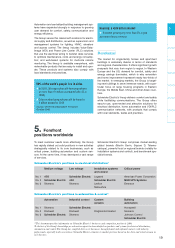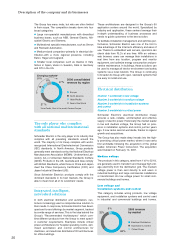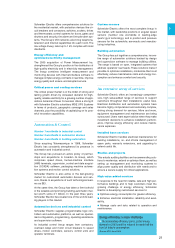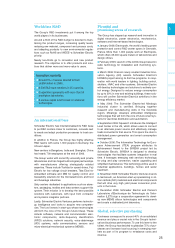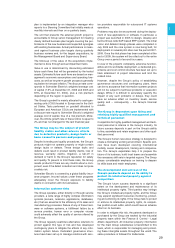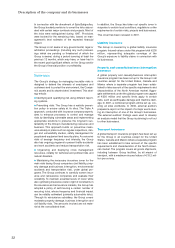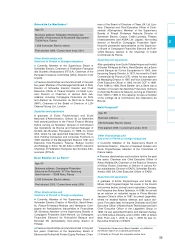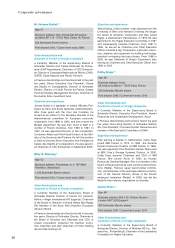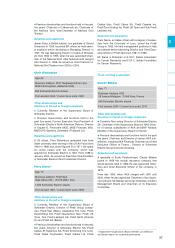APC 2006 Annual Report Download - page 29
Download and view the complete annual report
Please find page 29 of the 2006 APC annual report below. You can navigate through the pages in the report by either clicking on the pages listed below, or by using the keyword search tool below to find specific information within the annual report.
The Group is in the process of deploying a global
human resources management system. Designed with
input from human resources managers and team
members around the world, the system is based on a
shared set of job classifications and competencies that
provides the basic information needed for human
resources management. The system was tested in
France and India in 2006 and will be gradually
deployed across the Group starting in 2007.
The system’s competency plans allow the country
organizations and various departments to define the
skills sets they will be needing in three years’ time
based on business plans and analyses of changes in
the business. This information can then be used to
establish the necessary hiring, training and mobility
programs. The competency plans are used in all the
Group’s units.
All employees have the opportunity to map out their
career paths with their managers during individual
competency interviews, taking into account changes
within the Group’s businesses. In this way, they can
discuss possible directions for development and
identify useful training programs. Lastly, the Group
gives employees a stake in achieving targets and in
Schneider Electric’s performance through profit-linked
incentive plans, employee share ownership, stock
option programs and bonuses.
Attracting
and developing talent
The diversity of the countries, markets and customers
served by Schneider Electric is reflected in its work-
force. The Group is committed to developing and pro-
moting multi-cultural teams with managers from differ-
ent countries who are able to take on major responsi-
bilities in a decentralized organization. This policy
helps Schneider Electric attract, lock-in and develop
the best people in all of its host countries.
The Group encourages geographic mobility and nur-
tures international leadership. This is one of the goals
of the Marco Polo international hiring program, which
recruits some 100 people a year. Marco Polo gives
high potential graduates interested in international
mobility the opportunity to kick off their Schneider
Electric careers with a job in a foreign country.
Training is a key success factor at all levels of the
organization. Schneider Electric has developed part-
nerships with prestigious business and engineering
schools and targeted universities around the world. In
2006, it stepped up its programs with INSEAD in
France, IESE in Barcelona and the London Business
School to bolster MBA recruitment.
Also during the year, Schneider Electric University
considerably expanded its programs on customer
focus, continuous change, leadership skills and atti-
tudes and professional expertise through several spe-
cialized institutes.
Seminars on developing leadership and global expert-
ise attracted 1,126 participants from 72 countries in
2006, an increase of 66% from 2005. More than 400
customers worldwide were interviewed as part of
these programs.
The Commercial Institute offers training for team mem-
bers in customer relations departments and centers.
The new Industrial Operations Institute held its first
sessions for 91 plant managers from around the world.
The Institute’s mission is to offer comprehensive train-
ing to current and future plant, purchasing and supply
chain managers.
The Felix program, which develops high potential jun-
ior managers worldwide, celebrated its tenth anniver-
sary in 2006. The year’s first session was held in Bei-
jing, with 31 participants from 23 countries. Some of
the training was administered through the newly
opened Schneider Learning Institute China.
More than 4,000 employees benefited from e-learning
in 2006, notably for English language training. More
than 6,000 received training locally thanks to the
deployment of the Schneider Electric institutes’ pro-
grams in the Country Organizations. The Group is also
deeply committed to keeping its employees’ competen-
cies fresh through regular evaluations, appropriate
information and training and skills certification pro-
grams. When headcount needs to be scaled back, the
units take vigorous steps to find inplacement solutions
or to help those made redundant to start their own
businesses.
See Schneider Electric’s social performance indica-
tors, pages 73-90.
A global program
to promote workplace health
and safety
Defined in 2005, the Group’s health and safety policy
is discussed in all of Schneider Electric University’s
management seminars. The policy was widely distrib-
uted among the units in 2006, with the Country Orga-
nizations responsible for deploying action plans. A
health community was created to share and spread
best practices within the Group.
Each year, the local health and safety policy is formal-
ized and presented to employees. The number of days
lost due to work injuries is tracked on a monthly basis
in all host countries to get a precise view of the local
action plans’ impact. The goal is to reduce the number
of lost days from work accidents by 20% per employee
per year over the period covered by the new2compa-
ny program.
Workforce
by region in 2006
n Europe
n North America
n Asia-Pacific
n Rest of the World
46
%
7
%
25
%
22
%
27
1




